We interviewed Mr. Hitoshi Tanaka, one of the development engineers at J. MORITA MFG. CORP., for stories about the Torqtech Red band Handpiece in Part 1 and the Torqtech Red band Handpiece Ultra Mini in Part 2.
Morita released the Torqtech red band handpiece Ultra Mini in October 2022 in response to requests from many dentists. This product was finally developed despite many difficulties through the high technological skills and persistent creative efforts by engineers at J. MORITA MFG. CORP. 12 years after the first release of the Torqtech series.

Part.1 Aiming for a Motor Handpiece with Competitiveness in the Global Market!
— First, what was the background of developing the Torqtech Red band Handpiece?
Tanaka: Dental handpieces are categorized into air turbines and motor handpieces. Air turbines are capable of fast rotation with high milling efficiency, while motor handpieces enable precise milling adjustment and polishing. Morita has held a large share in the air turbine market, releasing TwinPower Turbine in 2000, followed by the TwinPower Turbine X series with an anti-drawback mechanism in 2007, and the TwinPower Turbine Ultra series (Powerful Micro Head) achieving a compact turbine head in 2010. On the other hand, there were increasing needs from dentists for Red band Handpiece, among other motor handpieces, for fast rotation that combined milling efficiency and precise control. In those days, the development of Red band handpieces had been delayed in Morita. To develop a motor handpiece with competitiveness in the global market, we started the development of the red band handpiece to become a flagship product in our handpiece product range.
In the 2000s, in contrast to the smooth and hand-fitting body shape of air turbines, red band handpieces were made with square and rugged design without considerations for hand fitting or easy access. It was a common understanding in the industry that this design aspect could not be avoided due to the gear system constraints. However, as a latecomer in the red band market, Morita needed to develop a feature that could make our late coming product competitive in the market. This is why we decided to rigorously pursue the development of a red band handpiece with a body shape closer to that of air turbines.
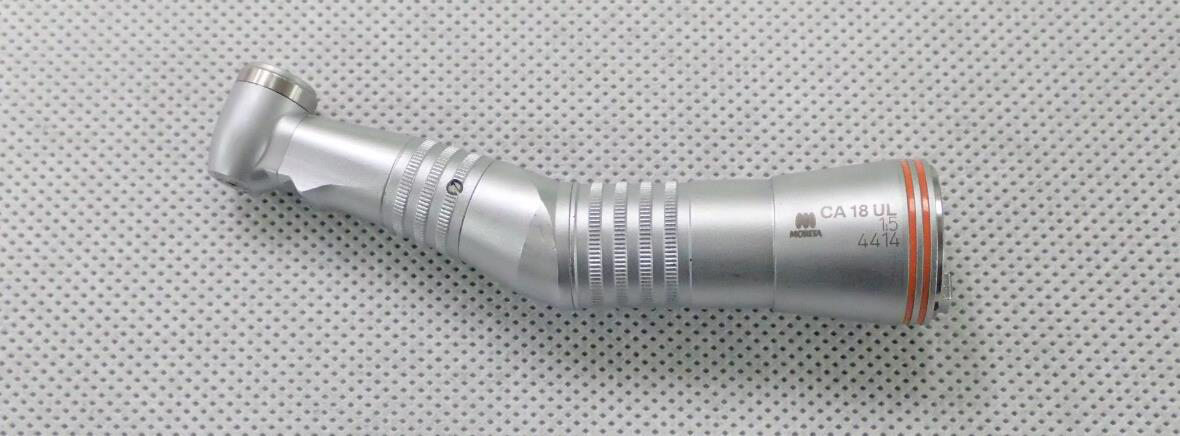 A red band handpiece in the 2000s had a square and rugged shape, which was common in the industry.
A red band handpiece in the 2000s had a square and rugged shape, which was common in the industry.
Inside its body, the red band handpiece increases the input rotation five times from 40,000 rpm to 200,000 rpm. This rotation is nearly 100 times faster than that of an automobile engine, which rotates at several thousands of rpm, indicating how durable the gear system incorporated in the product needs to be.
— Could you describe in more detail why the red band handpiece in those days had such a rugged shape?
Tanaka: In those days, a red band handpiece was built with two gears. The five times speed increase was achieved by about 3.7 in the body angle part, and about 1.3 inside the head. In designs based on this conventional concept, it could not be avoided to design a product with a protruding lower angle part, which interfered with front teeth during access to the molar. This was a substantial disadvantage of the red band handpiece, which could not have an ideal body shape due to more complex internal mechanisms compared to turbines.
— That was the reason all other competitors' models had similarly rugged shapes?
Tanaka: Yes. As I mentioned earlier, Morita had delayed in the development of red band handpiece. Therefore, our late coming product needed to have a distinctive feature to be accepted in the market. This is why we started development focusing on a turbine-like smooth body shape and durable gear system.
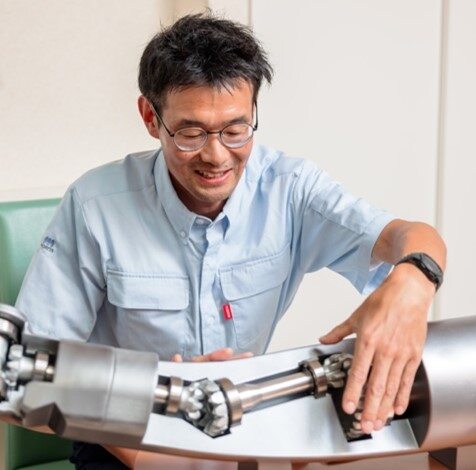
— How did the actual development proceed?
Tanaka: In a usual process, the design of a gear system starts with the gear part, and the body was shaped to suit the gear structure. However, this procedure only led to shapes similar to those of conventional products. Therefore, we decided to determine an ideal body shape first, and subsequently figure out how to contain the gear system inside it. We repeated trials and errors through this reverse thinking. The double internal bevel gear system was developed through this process. We succeeded in laying out a gear system inside the body designed as above by increasing from two to three gear sets and slightly inclining the central axes. This substantially improved hand fitting and access to the molars, making a great advancement in the reduction of burdens on dentists and patients.We are confident that this is the most ideal shape achievable at present, because further reduction in the gear size would compromise durability due to technological obstacles.

Development was achieved through reverse thinking to determine an ideal body shape first and subsequently exploring how to contain the gear system inside it as illustrated (the dotted lines indicate the conventional shape of red band handpiece).
— Could you describe the double internal bevel gear system in more detail?
Tanaka: To contain the gear system inside the predetermined body shape, it was essential to increase from the conventional two to three gear sets, as I mentioned earlier. By dividing gears into two stages, we could lay out the gears in steps, thereby achieving reduction in the protruding lower part, which had been the conventional problem. However, it was impossible to contain the gear system in the body shape if the first axis and second axis were laid out in parallel, because of difficulty in reducing the size of the upper angle part. We examined many gear layouts, and finally developed a double internal bevel gear system, which had an inclined second axis and used an internal gear mechanism advantageous for speed increase for the first and second gear stages.
Mechanism of double internal bevel gear system It became possible to contain the gear system inside the predetermined body shape by increasing from two to three gear sets and laying them out with respectively inclined axes.
It became possible to contain the gear system inside the predetermined body shape by increasing from two to three gear sets and laying them out with respectively inclined axes.
— What is the internal gear mechanism?
Tanaka: The external gear mechanism is a common gear structure, where gears mesh externally with each other. In contrast, internal gear mechanisms havesa structure where a gear meshes against another gear that has teeth inside it. This structure achieves larger teeth in a smaller space, with increased gear strength and durability. On the other hand, it causes difficulties in processing. In particular, precise processing is considered extremely difficult for internal gears with inclined axes. The outer circumference of usual gears can be processed using a cutter. On the other hand, this usual processing is difficult for a gear with internal teeth, which needs be cut out using a pencil-like tool called a “ball end mill.” It had been unthinkable in common understanding to use this method for two gear sets, because it took so much time and labor. The double internal bevel gear system was a challenge to this preconception.

Structure of the gear system Torqtech Red band handpiece use double internal gear sets. By using internal gears with inclined axes, despite the extreme difficulties in processing, the product achieves increased gear strength, durability, and access, thereby prioritizing precise treatment that benefits both dentists and patients.
Torqtech Red band handpiece use double internal gear sets. By using internal gears with inclined axes, despite the extreme difficulties in processing, the product achieves increased gear strength, durability, and access, thereby prioritizing precise treatment that benefits both dentists and patients.
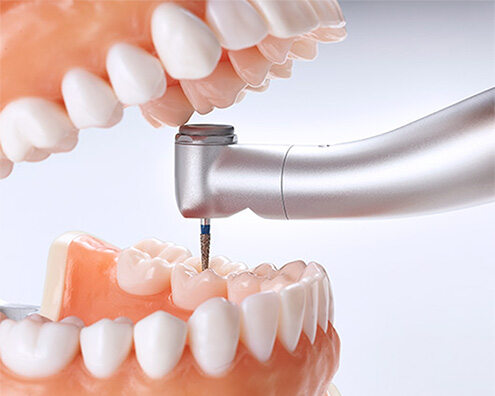 Torqtech red band handpiece achieved a turbine-like smooth body shape, thereby providing efficient access to the treatment area while reducing contact with the opposing teeth.
Torqtech red band handpiece achieved a turbine-like smooth body shape, thereby providing efficient access to the treatment area while reducing contact with the opposing teeth.
However, because the double internal bevel gear system was extremely specialized, there had been no means for measuring whether the processed shape conformed to the design. Therefore, we needed to develop a dedicated shape measuring device in collaboration with a device manufacturer. In those days, there were opinions in the company that doubted the commercialization of a high-quality red band handpiece. An unprecedented investment also became necessary to develop a measuring device in addition to the design of the Torqtech unit. (The double internal bevel gear system has been evaluated for its innovativeness and awarded Patent No. 5645447.)
— Does the Torqtech red band handpiece have any other features you want to emphasize?
Involute tooth profile Torqtech red band handpiece use an involute tooth profile based on involute curves, thereby achieving smooth rotation that minimizes stress.
Torqtech red band handpiece use an involute tooth profile based on involute curves, thereby achieving smooth rotation that minimizes stress.
Tanaka: Just like turbines, Torqtechs need lubrication, but are not continuously immersed in oil, unlike automobile gears. Therefore, we needed to design the gears to withstand friction with only a thin layer of oil. This really highlights the importance of the precision and durability of gear teeth. Torqtech red band handpiece use an involute tooth profile based on involute curves for all its gears. An involute curve is a curve formed when a string is wrapped around a circle and then unwrapped. A gear processed in this shape minimizes slipping, rotates smoothly and efficiently, and reduces friction. Nevertheless, the gear would rapidly wear out if made of a common material. We use a special material that is extremely hard and withstands friction.
PART.2 Torqtech Red band Handpiece Ultra Mini: Untold Stories Aiming to Develop the Most Compact Size in the World!
— In 2022, Ultra Mini joined the portfolio of the Torqtech red band handpiece series.
Tanaka: At the same time as the Torqtech series was released in 2010, Morita also released an air turbine of the TwinPower Turbine Ultra series (Powerful Micro Head). The power of a turbine decreases if its head size is reduced, because the impeller would also become smaller. Morita introduced a new double impeller mechanism, which achieved strong power and constant torque and was highly evaluated by dentists.
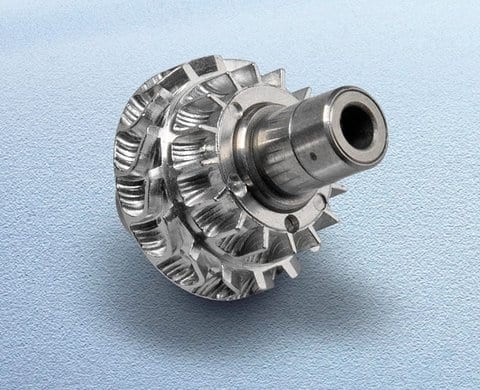 Double impeller system of the TwinPower Turbine
Double impeller system of the TwinPower Turbine
We also received many requests for a smaller head size for the red band handpiece. However, to realize this, there were unique difficulties that were not present in the downsizing of a turbine head. The downsizing of a turbine head is achieved by reducing the size of the impeller. In contrast, because a red band handpiece is driven by a motor, downsizing gears in the same manner would result in larger burdens on the gears and bearing, causing a problem in durability. Therefore, we needed to downsize the bearing without altering the gear system, while increasing its durability.
— There were unique difficulties that were not present in the downsizing of a turbine head. How did you improve the bearing?
Tanaka: A common bearing has an inner ring and an outer ring, respectively on the inside and outside of a ring-shaped groove where the balls rotate, with an inner retainer that retains the balls at equal intervals. The retainer is the most crucial element of a bearing and is also the most vulnerable to damage. Whereas metal materials are commonly used for retainers, a metal retainer rapidly wears out through fast rotation. Therefore, we use a special resin material for the Ultra Mini. Whereas resins are inferior to metals in strength, their extreme lightweight is stronger than metals against wear through fast rotation. Common resins easily deteriorate at high temperature and are therefore extremely vulnerable to sterilization, with the risk of damage due to compromised strength through repeated autoclaving. To solve this problem, we use a special resin material featuring both heat and steam resistance for the retainer part of the Ultra Mini.
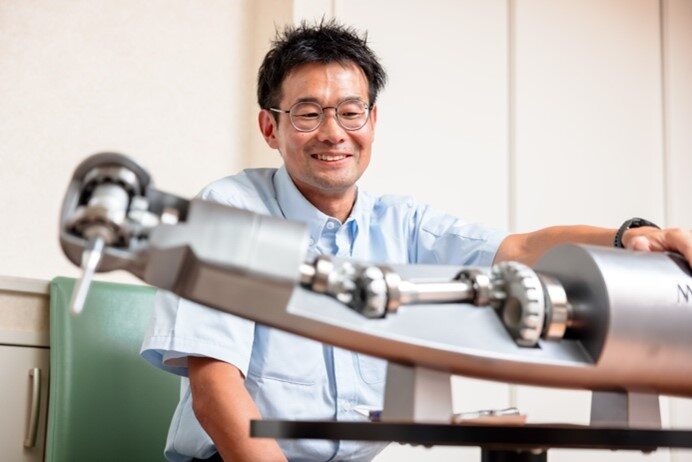
— Did you also improve the structure, in addition to the material?
Tanaka: There are two structures for bearings: deep groove bearings and angular bearings. A deep groove bearing has a ball placed on a deep groove, with the retainer holding the ball from one side and capping it with the outer ring. This is the structure used for conventional red band handpieces. The Ultra Mini uses an angular bearing, which withstands a larger axial load than a deep groove bearing. An angular bearing has a groove only on one side, with a basket-shaped retainer that holds the ball from all sides. By using an angular bearing, we achieved about twice the retainer strength and reduced axial runout. Through repeated experiments and durability tests, we achieved the present bearing specification over a period of about five years. The bearing is the core of turbines and contra-angles and is the most vulnerable to damage. Because technology continuously advances over time, our development has never ceased even after the release of the Ultra Mini in 2022.
— The Ultra Mini also has an improved water injection method.
Tanaka: A conventional red band handpiece uses a " three-port water irrigation system". In the case of three-port water injection, a complicated pipeline is required inside the head, which inevitably increases the head height. Therefore, the "Ultra Mini Head" uses a "single-port water irrigation system". However, with the single-port water injection used in general small heads, the water injection power is simply reduced to one-third. In the case of a red band handpiece, they are often used under higher loads than air turbines, and cooling the bur is important because heat generated in the cutting area may have an adverse effect on the tooth pulp. In order to avoid this issue, we developed and all-new "wide single-port water irrigation system". It has a water injection port in the center and two chip air holes on each side for a total of 4. This mechanism aims the water flow at the center and spreads it out in a fan shape. This makes it possible to cool a wider area from the shank of the bur to the tip. With single-port water injection, the water could easily miss the bur, which could cause the bur to heat up and cause the teeth to char. "Wide single-port water irrigation" realizes a unique single-port water injection hole that is unaffected by water and chip air pressure. (The wide one-port system is patent pending.)
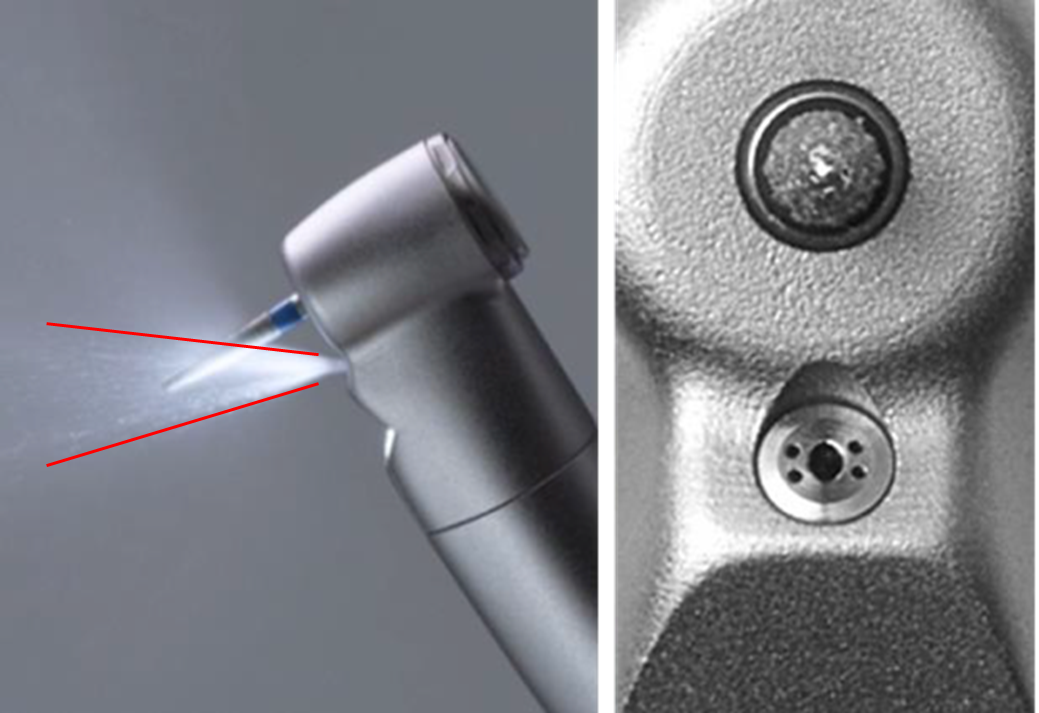 Water spraying with the wide one-port system
Water spraying with the wide one-port system
(Left) Accurate water injection (Right) Inaccurate water injection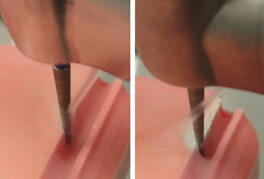 (The photos were taken without chip air. Due to the temperature increase of the bur, the temperature indicating material has changed its color to white to indicate high temperatures.)
(The photos were taken without chip air. Due to the temperature increase of the bur, the temperature indicating material has changed its color to white to indicate high temperatures.)
— What ideas were used in the wide one-port system?
Tanaka: Unlike common chip air tubing, which has one tube through to the air outlet, the Ultra Mini has a tube that branches to four air outlets. The holes are so small that it is difficult to visually find them on the actual product. Each hole is only 0.2mm, about the size of hair. Specialists with long experience in processing have combined their expertise to realize this product. Engineers engaged in production upgraded their skills through in-house training to handle the extremely precise processing and complex assembling necessary to produce the Ultra Mini. The final assembling and product inspection require especially high skills that only several engineers are certified for. Although this may not be an ideal process from the viewpoint of productivity, we cannot avoid this aspect in pursuit of the most compact size and the highest durability in the world. I hope that clinicians will immediately feel the difference and experience the high usability and durability achieved through all these efforts.
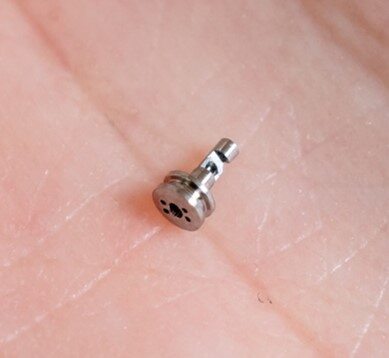
We consider that, by going our way to boldly select precise and complex processing and assembling, we may be able to establish our unique and unparalleled characteristics. We cannot afford to compromise the knowledge, skills, and passion that we have inherited from our predecessors. We realized the Ultra Mini by aiming to develop the most compact head size in the world, resolving many difficulties one after another through concerted efforts of the development and manufacturing teams.

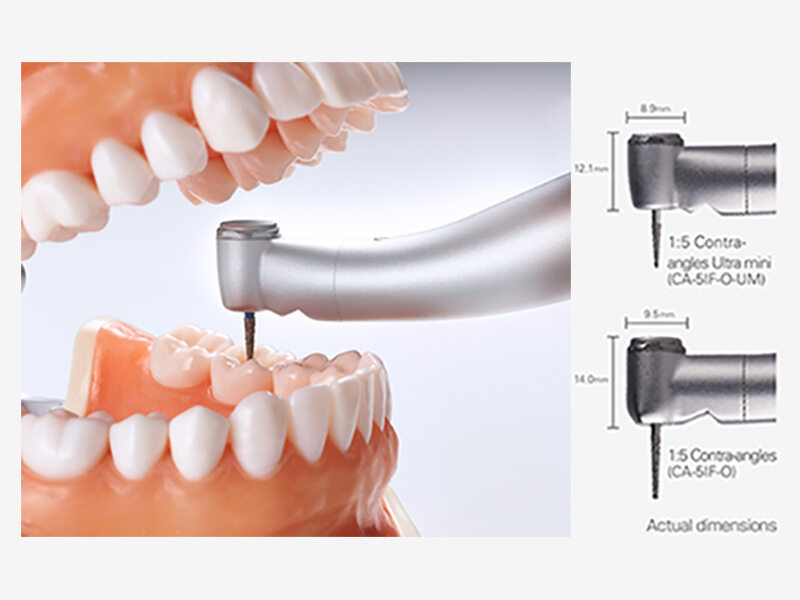
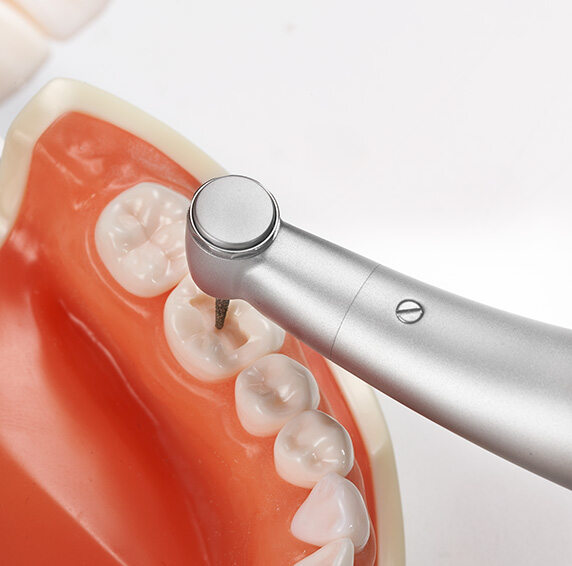
 Size comparison between Torqtech Red band Handpiece Standard vs. Ultra Mini
Size comparison between Torqtech Red band Handpiece Standard vs. Ultra Mini





